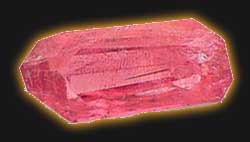
The name comes from "Rhodos", Greek for Rose colored. It commonly has black veins of manganese oxide, especially in larger specimens. Rhodonite is a manganese silicate and forms in the triclinic crystal system. It occurs in both a crystallised and massive, fine-grained form.It is deep pink to red and opaque, with dark veins of manganese lending some patterning.
Rhodonite is primarily used as a semi precious ornament, or as a minor ore of manganese.Rhodonite is often confused with Rhodochrosite and the rare mineral Pyroxmangite.
Rhodonite commonly occurs with Calcite, Willemite, Franklinite, Tephroite, Spessartine, Pyrolusite, Pyrite, Microcline, Pyroxmangite and other manganese minerals.

Sign of Rhodonite: Taurus
Helps us express confidence and lovingness on physical plane in day to day ways. Calms and feeds the soul through the heart.Very good for speech and hearing problems. This stone may engender balance through strength of will. As a "karma" stone, it may also accelerate the inevitable consequences of cause and effect. Rhodonite raises self worth and helps ward off negativity. It has been known as a "Rescue Stone". Rhodonite soothes the nervous system.This is a balance gemstone and is used to clear the psychic centers.
The Russians of earlier years were known for their rhodonite carvings. The sarcophagus of the Russian emperor Alexander II (1818-1881) was carved from a single block of Rhodonite.
Russia, Australia, Langban, Sweden, Brazil, Massachusetts, Sussex County, New Jersey,Colorado, California, and throughout the Rocky mountains.
